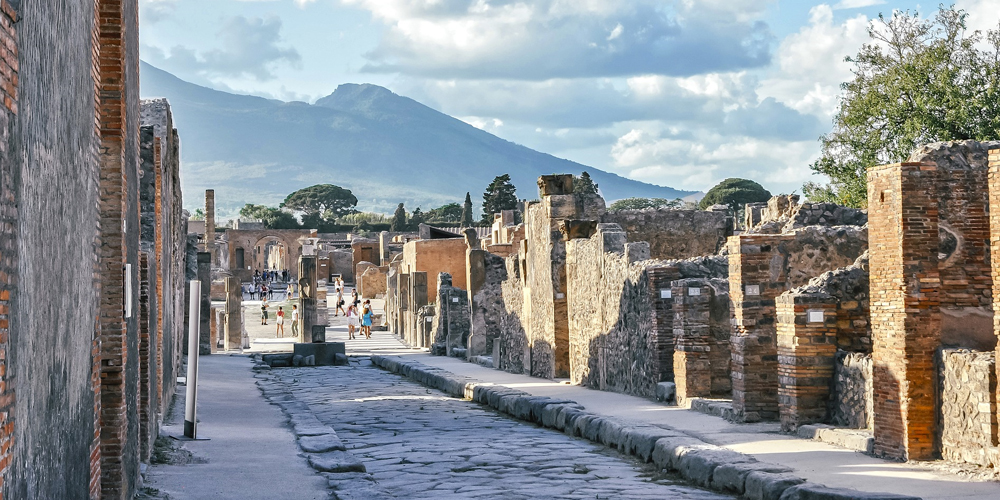The cardinal points of the city of Naples
Naples began its expansion towards the
east since the times of the Greeks and Romans, so much so that the most important testimonies of this expansion are located just east of Naples: Pompeii, Herculaneum and Paestum. But in addition to these symbols of classicism, the area east of Naples is also a receptacle of noble palaces from the eighteenth and nineteenth centuries.
But let's find out together what are the attractions that are located east of Naples.
The beauties of East Naples: the Golden Mile
In the
east of Naples exists a world which is the least known of the city but which hides unique amenities. After passing the historic centre and the industrial area we come across one of the longest roads in Naples that goes towards Salerno and crosses all the Vesuvian villages and which is improperly called the
Golden Mile. The Golden Mile indicates that strip of land that connects San Giovanni a Teduccio to Torre del Greco, but the origin is very different. The term was coined at the end of the eighteenth century, to indicate that stretch of road (precisely one mile) that led from Ercolano to Torre del Greco. The meaning "Golden" was added to celebrate the gardens full of pometes and the presence of splendid Vesuvian villas of the eighteenth century that bordered the road.
Before going into the real Golden Mile, I have to, however, mention some beauties that we meet on the road that leads us to the original mile. Not far from this iter is the famous mural district, a complex of social housing buildings, which have been decorated with works by famous artists all over the world, above all, the murals by Jorit Agoch called Diego Armando Maradona and Ernesto Che Guevara are really unmissable.
Continuing you can visit the National Railway Museum of Pietrarsa, with splendid exhibitions of historic locomotives, and in the Reggia di Portici, the royal palace commissioned by Charles III of Bourbon. The itinerary takes us to the Villa Dei Papiri, so-called for the presence of more than a thousand papyri inside, which acts as a "prologue" to the excavations of Herculaneum. The excavations are an obligatory stop in East Naples, their expansion is very small because the rest of the city is buried under today's Herculaneum after the eruption in 79 AD.
Now we arrived at the real and original Golden Mile that starting from Herculaneum from the entrance portal of the Villa del Bisogno in Corso Resina in Ercolano, after the entrance of the archaeological excavations, and in Corso Vittorio Emanuele in Torre del Greco, along which stood, among others, the Villa Campolieto, Villa Favorita, Villa Aprile in Ercolano, Palazzo Vallelonga, Villa Mennella, Villa delle Ginestre and Villa Macrina in Torre del Greco.
The Vesuvius National Park
The Vesuvius National Park is a fundamental stage of tourism in eastern Naples, not only for the scenic places but also for the animal and vegetable species and the geological singularities that are found on its crater. Among the best places to visit in the National park is undoubtedly the Valley of Hell and of course the crater of Vesuvius itself.
Pompeii and its excavations
The route continues in the millenary city of Pompeii. From the end of the eighteenth century, the Roman city was brought to light, giving humanity not only paintings, mosaics, furnishings and buildings, but they allowed us to reconstruct the lifestyle in Roman times.
In 1748, during the reign of Charles III of Bourbon, the first excavation campaigns began, which continue today. Pompeii is boundless and visiting in one day is almost impossible, so there are several places that you cannot miss: the House of the Faun, the Amphitheater of Pompeii, the Great Theater, the Villa of the Mysteries, the Forum of Pompeii, the Temple of Apollo and many others.
The views of the Amalfi Coast
The farthest eastern border of Naples is the Sorrento peninsula with its pearls: Sorrento and the Amalfi Coast. There are many corners and breathtaking views that you can enjoy in the small towns that make up the peninsula, above all: Sorrento and Amalfi, related from Positano, Ravello, Maiori and Minori with their beautiful beaches and local history and culture.
Eastern Naples is certainly known for the aforementioned attractions, but it contains other dozens that deserve to be visited at least once.
Do not waste any more time and come to visit Naples more in the shadow of Vesuvius











Lascia un commento